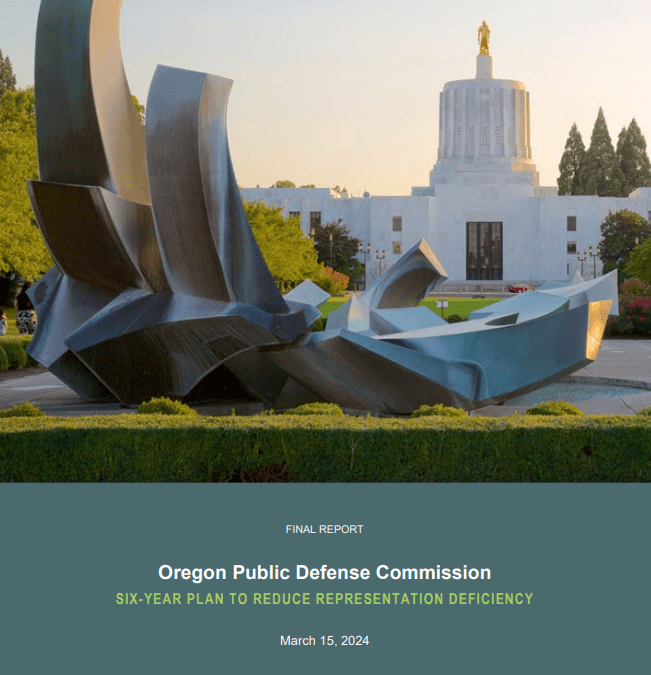Oregon’s Plan to Reduce Workloads and What it Means for Our National Workloads Strategy: A Reflection by Stephen F. Hanlon
A new report, prepared by Moss Adams, the largest accounting firm west of the Mississippi, with assistance from James Austin, Malia Brink, and myself, details a plan for the Oregon Public Defender Commission (OPDC) to implement the criminal case workload standards outlined in the Oregon Project over a six-year period.
Relying upon updated caseload data, the report concludes that Oregon needs 1,070 attorneys to provide ethical and constitutional legal services for its adult criminal caseload. Oregon currently has 506 attorneys to meet that need, which is a deficiency of 564 attorneys. The report demonstrates that Oregon can overcome that deficiency by 2031 by adding 80 attorneys per year to the public defense workforce over a six-year period.
The report also notes that a plan solely focused on adding attorneys to the workforce is the most expensive approach to implementing the workload standards. It demonstrates how the public defender deficiency could be resolved more quickly and cost-effectively through a series of other measures:
- Investing in non-attorney professionals such as paralegals, investigators, social workers, case managers, interpreters, and other administrative personnel. Such measures could reduce the deficiency by 192 attorneys.
- Decriminalizing certain offenses that are non-violent or have no victim. Such measures could reduce the deficiency by 198 attorneys.
- Sentencing reform, such as repealing the mandatory sentencing provisions of Ballot Measure 11 or exempting certain offenses from its scope. Such measures could reduce the deficiency by 52 attorneys.
Implications for a National Strategy to Adequately Fund Public Defense in America
The Oregon Six-Year Plan provides an excellent working model for a national strategy to adequately fund indigent defense throughout the nation. Many states, led by Washington, Kansas, Massachusetts, and Maryland (the ones we know about now), are applying the National Public Defense Workload Study to their caseloads and reporting the resulting public defender deficits to their legislatures and courts. New Mexico, like Oregon, has five-year plan to reduce deficits (the 5- or 6-year timeline depending on when legislatures meet).
I have sent the Oregon 6-Year Plan to Congresswoman Suzanne Bonamici (D-OR), who is the lead House sponsor of the Equal Defense Act in the House. She will give a video keynote address for the ABA Summit in an excellent 15-minute presentation. I also sent the Oregon 6-Year Plan to Senator Cory Booker’s lead person on this issue; Senator Booker is the lead sponsor of the companion bill, the Quality Defense Act, in the Senate, which provides a five-year funding cycle for complying states.
We have formed a new national organization to implement this strategy, named the Quality Defense Alliance (QDA). The initial members of the QDA are my old law firm, Holland & Knight, Moss Adams, The JFA Institute (James Austin, the nation’s leading expert on our prisons and jails), my firm LAWYER HANLON and NAPD. The QDA will advocate for Five-Year Plans similar to Oregon’s and New Mexico’s that we have already done with Moss Adams, and Holland & Knight will litigate when necessary and advisable to enforce those plans. The ACLU and the National Lawyers’ Committee joined us as amici in our first case in Oregon.
The primary goal of the QDA is to get as many states as possible to apply the NPDWS to their statewide caseloads and then adopt 5-year plans similar to Oregon’s and New Mexico’s so that we will have many states ready to receive supplemental federal funding for more public defenders and more student loan forgiveness when the Equal Defense Act and Quality Defense Act are passed by a future Congress (after November). We have bi-partisan support for this legislation.
Ben Polk, a Visiting Professor at NYU, is working under a grant to quantify the amount of supplemental federal funding that will be required to adequately fund these programs over a period of five years.
The Need for Federal Action
Gideon v. Wainwright is an unfunded federal judicial mandate on the states. The states have never had the necessary incentives to adequately fulfill that mandate, and they never will, absent federal intervention. In short, they are not about to triple the size of public defender budgets anytime soon. They have had 60 years to do that, and with rare exception, they are not even close. Thus, there is a compelling case here for supplemental federal funding to fulfill this unfunded federal judicial mandate on the states.
Most importantly, this national strategy is supported by a compelling public narrative that emphasizes that significant public defense reform (the end of the plague of excessive workloads) will incentivize significant criminal legal system reform (decriminalization of non-violent crimes and sentencing reform).
It took us – all of us in our profession, including judges, lawyers, bar associations and advocacy organizations – 60 years to dig this hole. We are not going to dig out of it overnight. But we are not going to wait another 60 years. Five years is a very reasonable number. And yes, there is a national plan, and yes, it is based on reliable data and analytics, and yes, we can advocate for it across the country, and yes, we can and will litigate to enforce the NPDWS in non-complying states with receptive state supreme courts.
Stephen F. Hanlon is a leading national advocate on public defense workloads and Founding Co-chair of NAPD’s Workloads Committee. Read more about him at lawyerhanlon.com.
The article was originally posted here.

